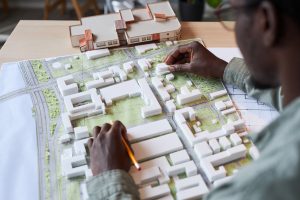Urban Planning and Community Design: Crafting Livable Cities


Urban planning and community design have emerged as pivotal fields in the quest to design cities that not only accommodate growth but also enhance quality of life. These disciplines are not just about creating spaces but about fostering environments where communities can thrive. Livable cities are characterized by their vibrant public spaces, efficient transportation systems, sustainability, and a strong sense of community. This article delves into the critical aspects of urban planning and community design that contribute to the creation of livable cities.
The Essence of Urban Planning
Urban planning is the process of designing and regulating the use of spaces to shape a city’s physical configuration. It involves strategic decision-making about the allocation of land resources, infrastructure development, and the overall layout of urban environments. The goal is to ensure that cities develop in a way that is both sustainable and conducive to the well-being of their inhabitants. Practical urban planning addresses current urban challenges while anticipating future needs, thereby laying the groundwork for communities to flourish.
Community Design: A People-Centered Approach
Community design focuses on creating spaces that reflect the values, needs, and aspirations of the people who live in them. It emphasizes participatory planning, where community members are actively involved in the design process, ensuring that the outcomes are socially inclusive and equitable. This approach fosters a sense of ownership and pride among residents, which is crucial for the long-term sustainability of urban projects. Community design also prioritizes the creation of public spaces that encourage social interaction and strengthen community bonds.
Integrating Green Spaces in Urban Environments
One of the hallmarks of a livable city is the presence of abundant green spaces. Parks, gardens, and natural landscapes offer residents a respite from the urban environment and contribute to physical and mental well-being. Beyond their recreational value, green spaces play a critical role in enhancing urban ecology. They help manage stormwater, reduce heat islands, improve air quality, and support biodiversity. Urban planners and designers must, therefore, prioritize the integration of green spaces into the urban fabric, ensuring they are accessible to all city dwellers.
Sustainable Urban Mobility
A livable city offers its residents efficient, affordable, and sustainable transportation options. These include a well-connected public transit system, safe and accessible walking and cycling paths, and policies that encourage the use of low-emission vehicles. Sustainable urban mobility reduces reliance on private cars, decreases traffic congestion, and improves air quality. It also makes cities more inclusive by ensuring that everyone, regardless of age or income, has access to mobility options that connect them to jobs, education, and other essential services.
Housing and Social Equity
Addressing the challenge of affordable housing is central to the concept of livability. A city cannot be genuinely livable if a significant portion of its population struggles with housing insecurity. Urban planning and community design must, therefore, incorporate strategies to ensure a diverse range of housing options that are accessible to all income levels. This includes not only the construction of affordable housing units but also policies that protect against displacement and gentrification, ensuring that urban development does not come at the cost of social equity.
Economic Development and Livability
Economic vitality is a critical component of livable cities. Urban planning and community design should facilitate economic development by creating environments that attract businesses and support local economies. This includes designing mixed-use neighborhoods that combine residential, commercial, and recreational spaces, thereby fostering lively and economically diverse communities. Economic development strategies should also prioritize job creation, particularly in sectors that contribute to the city’s sustainability goals.
The Role of Technology in Urban Planning
Advancements in technology are providing urban planners and designers with new tools to create more livable cities. From data analytics and GIS mapping to innovative city technologies, these tools can help in making informed decisions about urban development. Technology can also enhance the livability of cities through innovations such as intelligent transportation systems, energy-efficient buildings, and digital platforms that facilitate civic engagement and community building.
One of the most significant challenges and opportunities of our time is crafting livable cities through thoughtful urban planning and community design. By focusing on sustainability, inclusivity, and community, cities can transform into vibrant, healthy, and resilient environments. The path toward livability is complex and requires the collaboration of policymakers, urban planners, community organizations, and residents. However, by prioritizing the well-being of both people and the planet, we can create urban spaces that are not only functional but also inspiring places to live.
